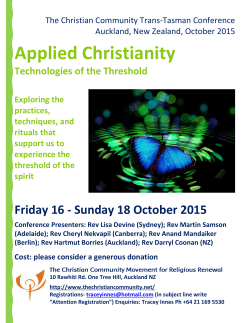
Quantum Tests of the Einstein Equivalence Principle on Ground and
Quantum Tests of the Einstein Equivalence Principle on Ground and in Space Invited Speaker: Ernst Rasel rasel@iqo.uni-hannover.de The Einstein equivalence principle is a corner stone of general relativity and therefore challenged with growing precision by experimental tests on ground [1,2] and in space [3]. In the recent past several atom-interferometric experiments were started with the aim to perform precise tests of the universality of free fall with quantum matter displaying unique features such as a long coherence length or pure sin polarisation [9-10]. They aim to reduce the present sensitivity gap between current ground based tests and a future space mission STE-QUEST [11,12], which will allow to improve on the ultimate systematic uncertainties of ground based experiments. A more elaborate version of STE-QUEST is proposed for The ESA M4-mission. It will host a dual species interferometer for testing the universality of free fall as well as enable intercontinental comparisons of state-of-the-art ground clocks for a test of the sun and moon gravitational redshift. Acknowledgement: The M4 proposal of STE-QUEST was established by a consortium of European scientists under the lead of Peter Wolf. Core scientists: Kai Bongs, Philippe Bouyer, Claus Braxmaier, Davide Calonico, A. Michael Cruise, Naceur Gaaloul, Luciano Iess, Philippe Jetzer, Wolf D.C. von Klitzing, Steve Lecomte, Ernst Rasel, Markus Rothacher, Stephan Schiller, Carlos F. Sopuerta, Guglielmo M. Tino, Philip Tuckey, Martin Zelan Additional contributions: Holger Ahlers, Peter Berg, Michael Chwalla, Robert Ecoffet, Thorsten Feldmann, Domenico Gerardi, Christine Guerlin, Jonas Hartwig, Thierry Martin, Didier Massonnet, Katerine PossoTrujillo, Christian Schubert, Thilo Schuldt, Drazen Svehla [1] J. G. Williams, S. G. Turyshev, D. H. Boggs, Phys. Rev. Lett. 93, 261101 (2004). [2] S. Schlamminger, K.-Y. Choi, T. A. Wagner, J. H. Gundlach, and E. G. Adelberger, Phys. Rev. Lett. 100, 041101 (2008). [3] P. Touboul, G. Métris, V. Lebat, and A. Robert, Class. Quantum Grav. 29, 184010 (2012). [4] S. Fray and M. Weitz, Space Sci. Rev. 148, 225 (2009). [5] A. Bonnin, N. Zahzam, Y. Bidel, and A. Bresson, Phys. Rev. A 88, 043615 (2013) [6] M. G. Tarallo, T. Mazzoni, N. Poli, D.V. Sutyrin, X. Zhang, and G. M. Tino, Phys. Rev. Lett 113, 023005 (2014) [7] G. Varoquaux, A. Landragin, R. A. Nyman, R. Geiger, P. Cheinet,and P. Bouyer, New J. Phys. 11, 113010 (2009). [8] S. M. Dickerson, J. M. Hogan, A. Sugarbaker, D. M. S.Johnson, and M. A. Kasevich, Phys. Rev. Lett. 111, 083001 (2013). [9] A. Sugarbaker, S. M. Dickerson, J. M. Hogan, D. M. S.Johnson, and M. A. Kasevich, Phys. Rev. Lett. 111,113002 (2013). [10] H. Müntinga et al., Phys. Rev. Lett. 110, 093602 (2013). [11] D. N. Aguilera et al., Class. Quantum Grav. 31, 115010 (2014) [12] G. M. Tino and M. Kasevich (eds) 2013 Precision interferometry with Bose-Einstein condensates (Atom Interferometry vol 188) (Proceedings of the International School of Physics "Enrico Fermi") N. Gaaloul, J. Hartwig, C. Schubert, W. Ertmer, and E. M. Rasel
© Copyright 2025





















